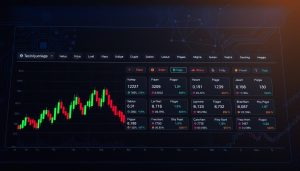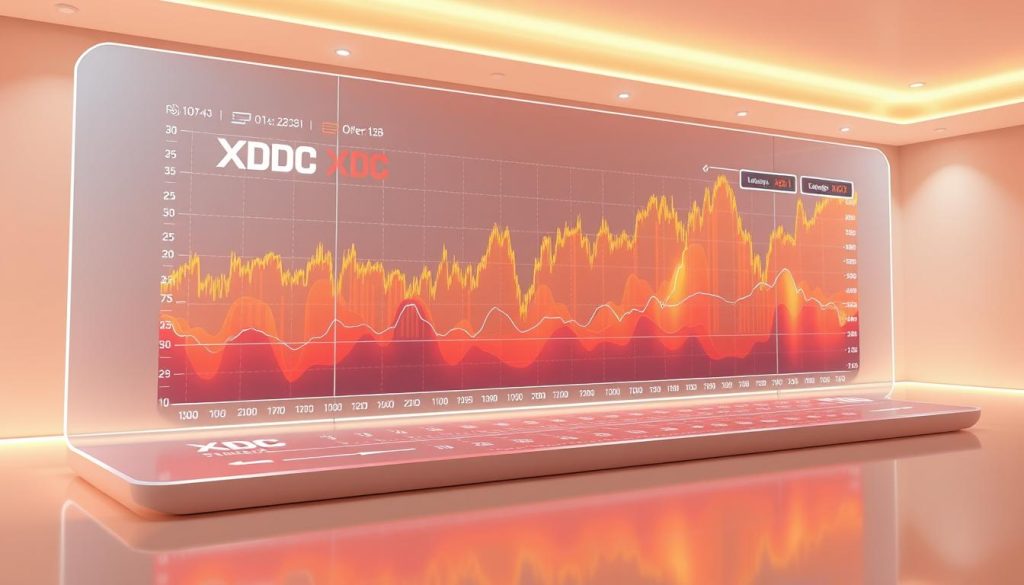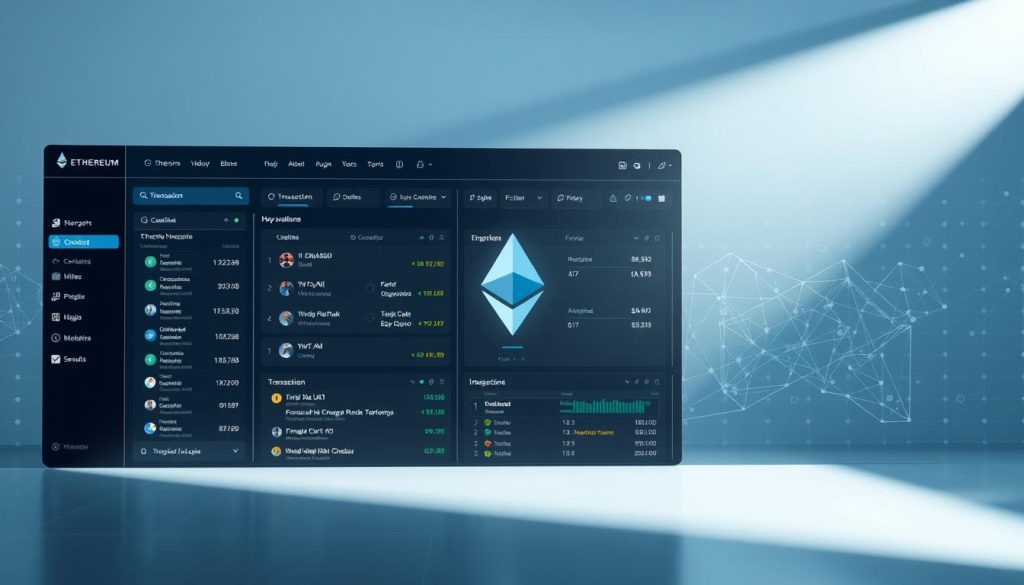TeraWulf processes over 69 million shares daily. Its market cap exceeds $1.88 billion. This shows the massive scale of cryptocurrency mining today.
Since 2019, I’ve watched this industry grow. It’s no longer about basement setups. The landscape has changed dramatically.
Big money now flows through crypto mining. Bit Digital, for example, has a $694.40 million market cap. It trades 46 million shares regularly.
Starting your own mining operation is easier than you might think. This guide shares my years of research and hands-on experience.
We’ll cover real hardware needs, not just hype. You’ll learn the true costs and practical issues often overlooked.
I’ll reveal my early mistakes and what actually works now. This knowledge is crucial in today’s competitive market.
Key Takeaways
- Bitcoin mining has evolved from basement operations to billion-dollar businesses
- Major mining companies like TeraWulf demonstrate the industry’s legitimate profit potential
- Hardware selection requires balancing initial costs with long-term efficiency
- Location and electricity costs significantly impact mining profitability
- Proper cooling and infrastructure planning prevents costly operational failures
- Market timing and cryptocurrency volatility affect mining farm success
Understanding Bitcoin Mining
Many dive into Bitcoin mining without grasping the basics. This can lead to poor equipment choices and unrealistic profit expectations. Understanding the process is crucial before investing in expensive mining hardware.
Mining isn’t just about earning cryptocurrency. It’s about securing the Bitcoin network through mathematical verification. This knowledge helps in making informed decisions about mining operations.
What is Bitcoin Mining?
Bitcoin mining verifies transactions and adds them to the blockchain ledger. Miners act as digital auditors who get paid for their work. Their hardware solves complex puzzles to prove transactions are legitimate.
Each solved puzzle adds a “block” of verified transactions to the blockchain. The term “mining” likens the process to extracting gold from the earth.
Mining is not just about creating new bitcoins. It’s about maintaining the integrity and security of the entire Bitcoin network through proof-of-work consensus.
How Mining Works
Mining follows a specific cycle that mining rigs repeat continuously. Understanding this process helps optimize your setup and hardware choices.
Your hardware receives pending Bitcoin transactions from the network. It then tries to solve a cryptographic puzzle for these transactions. This requires finding a specific number called a “nonce”.
When solved, you broadcast the solution to the network. Other miners verify it. If correct, your block joins the blockchain. You receive new bitcoins and transaction fees as reward.
| Mining Step | Process | Hardware Role | Time Required |
|---|---|---|---|
| Transaction Collection | Gather pending transactions | Network communication | Seconds |
| Hash Calculation | Solve cryptographic puzzle | Intensive computation | ~10 minutes average |
| Solution Broadcast | Share result with network | Network verification | Seconds |
| Reward Distribution | Receive bitcoin payment | Wallet integration | Minutes |
Why Mining Matters
Mining serves three critical functions that make Bitcoin possible. These functions show why investing in mining rigs contributes to more than personal profit.
Transaction Processing is the most visible mining function. Every Bitcoin transaction needs mining verification before completion. Without miners, transactions would remain stuck indefinitely.
Network Security comes from the proof-of-work consensus mechanism. The combined power of all mining hardware makes attacking the Bitcoin network extremely expensive.
Bitcoin Distribution happens through mining rewards. New bitcoins enter circulation only through mining, following a set schedule. This controls inflation and maintains Bitcoin’s scarcity.
Your mining operation supports the entire Bitcoin ecosystem. Quality mining hardware contributes to the security and functionality of a global financial network.
This knowledge is crucial when selecting equipment and planning your mining farm. Hardware specs directly relate to these fundamental mining functions.
Essential Equipment for Mining
Your mining success hinges on equipment choice. After years of testing, I know what works. You need reliable gear for continuous operation while managing power use.
Getting it right saves thousands long-term. Many newcomers buy cheap equipment, only to replace everything within months.
Mining Hardware Options
ASIC miners are the only real option for Bitcoin mining today. GPU mining ended years ago. Current ASIC miners deliver competitive hash rates.
The Antminer S19 series is my top pick. These units deliver 95-110 TH/s with good efficiency. S19 Pro models offer higher rates but use more power.
WhatsMiner’s M30S+ series provides solid alternatives. I’ve run both brands, finding minimal reliability differences. Choice often depends on availability and price.
Newer models like S19 XP are more efficient but costlier. Calculate your break-even point before investing in the latest tech.
Recommended Mining Software
Mining software is crucial for effective hardware function. I’ve tested many options over the years. A few stand out for reliability and features.
CGMiner is the gold standard for most operations. It supports virtually every ASIC miner and offers extensive customization. The learning curve is steep but worth it.
BFGMiner is another excellent option with similar capabilities. It includes additional monitoring features to track equipment performance. Both programs handle multiple miners well.
EasyMiner offers a user-friendly interface for beginners. It lacks some advanced features but gets you mining quickly. Choose mining software that matches your tech skills.
Most modern ASIC miners include built-in web interfaces. These work well for basic operations but limit optimization options.
Power Supply Considerations
Power supplies are often underestimated in mining setups. An ASIC miner draws 3,000+ watts continuously. Your PSU must handle this load reliably for months.
I recommend 80+ Gold certified power supplies for efficiency. The higher cost pays off through lower electricity bills. Platinum-rated units offer better efficiency but cost more.
Calculate your total power consumption, then add 20% headroom. This prevents PSUs from running at max capacity, extending their lifespan. Running at 80% capacity is ideal.
Never skimp on power supplies. A failed PSU can damage expensive mining hardware. Quality brands like Corsair, EVGA, and Seasonic offer reliable options.
Modular PSUs improve cable management in tight setups. Removing unused cables boosts airflow and reduces clutter around your equipment.
Setting Up Your Mining Farm Location
Your mining farm’s location can make or break your profit. Many newcomers rush into buying equipment without considering where to run it. The environment affects electricity bills and equipment lifespan.
A proper mining farm setup needs three key elements. These are power infrastructure, ventilation, and noise management. Getting these wrong leads to more troubleshooting than mining.
Choosing the Right Site
Industrial spaces are best for serious mining operations. I’ve worked with converted warehouses and repurposed manufacturing buildings. These places usually have the electrical capacity and ventilation you need.
Residential options work for smaller setups. Garages, basements, and spare rooms can serve miners well. However, power capacity and noise levels are limited in homes.
Most home electrical panels max out at 10-15 miners. Upgrades are needed beyond that point.
Consider these factors when picking a site:
- Electrical capacity – Can the existing infrastructure handle your power requirements?
- Ventilation potential – Does the space allow for proper airflow management?
- Noise tolerance – Will the constant hum of miners create problems with neighbors?
- Security – Can you protect expensive equipment from theft?
- Internet connectivity – Reliable internet access is essential for mining operations
| Location Type | Power Capacity | Ventilation | Noise Level | Setup Cost |
|---|---|---|---|---|
| Industrial Warehouse | High (50+ miners) | Excellent | Not a concern | $5,000-$15,000 |
| Residential Garage | Medium (10-15 miners) | Good with modifications | Moderate concern | $2,000-$5,000 |
| Basement | Low (5-10 miners) | Poor without upgrades | High concern | $1,500-$3,000 |
| Dedicated Shed | Medium (15-20 miners) | Good | Low concern | $3,000-$8,000 |
Importance of Climate Control
ASIC miners create a lot of heat. One Antminer S19 makes about 3,250 watts of heat. That’s like running three hair dryers non-stop.
Without good cooling, your equipment will slow down or shut off. I learned this the hard way in my first setup.
Proper airflow management isn’t optional – it’s the difference between a profitable operation and expensive paperweights.
Cooling systems need careful planning. Create a wind tunnel with intake fans on one side and exhaust fans opposite. This moves cool air in and hot air out quickly.
Keep a close eye on temperature, especially in summer. I keep it below 85°F (29°C) for best results. Higher temps reduce efficiency and wear out hardware faster.
Electrical Setup Requirements
Good electrical setup is crucial for mining success. Most miners need 240V circuits to work best. Using 120V wastes energy and makes extra heat.
For over 10-15 miners, get a pro electrical check. Have a licensed electrician look at your power capacity before buying equipment. This prevents tripped breakers and fire risks.
Calculate your power needs carefully. Each ASIC miner uses 1,500-3,500 watts. Add 20% for cooling and other gear. A 20-miner setup usually needs 60-80 kilowatts.
A proper electrical setup includes:
- Dedicated circuits for each group of miners
- Appropriate breaker sizing to handle startup surges
- Quality wiring rated for continuous high-amperage loads
- Surge protection to safeguard expensive equipment
- Emergency shutoffs for safety and maintenance
Don’t skimp on electrical work. Bad wiring is dangerous and wastes power. Good electrical setup pays off with reliable mining and lower bills.
Cost Analysis of Building a Mining Farm
Mining operations require careful financial planning. Many enthusiasts overlook proper cost analysis, leading to overly optimistic profitability projections. Accurate budgeting is crucial for success in this field.
Three critical cost categories impact your mining operation’s bottom line. Understanding these factors determines whether you’ll profit or lose money in the volatile crypto market.
Initial Investment Breakdown
A modest 10-miner operation typically costs between $30,000 to $50,000 upfront. This includes all necessary equipment to get your farm operational.
Hardware is the largest initial expense. Ten Antminer S19 Pro units cost about $20,000 to $25,000, depending on market conditions.
Electrical infrastructure often surprises new miners. Professional electrical work for proper circuits and safety systems runs $5,000 to $8,000 for a small operation.
Cooling and ventilation systems add another $3,000 to $5,000. Industrial fans and climate control equipment keep your miners running efficiently.
Ongoing Costs: Electricity and Maintenance
Electricity dominates operational expenses, typically consuming 60-70% of monthly costs. At $0.10 per kWh, ten S19 Pro units cost $2,160 monthly to operate.
Your electricity rate significantly impacts mining profitability. Rates above $0.12 per kWh make most operations unprofitable unless Bitcoin prices surge.
Budget around $50 to $100 per miner monthly for maintenance. This covers replacement parts, repairs, and facility upkeep.
Publicly traded mining companies reflect the industry’s profitability challenges. TeraWulf and Bit Digital stocks show significant volatility over the past year.
Return on Investment Predictions
Conservative estimates suggest 12-18 months payback under favorable conditions. However, Bitcoin’s price volatility makes these predictions highly unreliable.
Your ROI depends on constantly changing variables. Bitcoin price, network difficulty, electricity costs, and hardware efficiency all impact your returns.
| Bitcoin Price | Monthly Revenue (10 miners) | Monthly Profit | ROI Timeline |
|---|---|---|---|
| $30,000 | $1,800 | -$600 | Never |
| $50,000 | $3,000 | $600 | 67 months |
| $70,000 | $4,200 | $1,800 | 22 months |
| $100,000 | $6,000 | $3,600 | 11 months |
Analyzing mining profitability teaches us to manage expectations. Never invest money you can’t afford to lose entirely.
Successful miners focus on operational efficiency rather than hoping for price increases. They secure cheap electricity and maintain equipment properly.
This isn’t a get-rich-quick scheme. It’s a capital-intensive business requiring careful financial management and long-term planning.
The Role of Pools and Solo Mining
Solo mining Bitcoin proved financially disastrous for me. After three months, my first rig found no blocks. Then I discovered mining pools, which revolutionized my mining approach.
Choosing between solo mining and joining a pool is crucial. This decision greatly impacts your operation’s profitability. It’s not just a technical choice, but a survival strategy.
What is a Mining Pool?
A mining pool combines thousands of miners’ computational power into one network. It’s like a lottery syndicate where everyone contributes hash power. When the pool finds a block, rewards are distributed proportionally.
I’ve used mining pools since 2019. Your rig connects to pool servers and receives work assignments. When any pool miner solves a block, everyone gets paid based on their contribution.
Pool operators handle all technical complexities. They manage blockchain connections, validate transactions, and distribute payments. You simply connect your miners to their servers and start earning.
Benefits of Joining a Pool
Predictable income is the main advantage of mining pools. You receive steady payments instead of waiting months for a lucky block discovery. This consistency is vital for planning and operations.
Pools reduce variance significantly. Solo mining is like gambling – you might hit jackpot or go broke. Mining pools transform these wild swings into steady, predictable returns.
Established pools provide detailed performance statistics. You can track hash rate, efficiency, and earnings in real-time. This data helps optimize your setup and quickly identify issues.
Popular pools typically charge 1-3% fees. The services they provide – stable income, infrastructure, and detailed reporting – justify this cost.
Solo vs. Pool Mining: Which is Better?
Solo mining only works for massive hash power operations. You’d need hundreds of miners minimum. This requires serious capital investment and industrial infrastructure.
Small operations face brutal mathematics. A single ASIC miner might find a block once every few years. Mining pools offer consistent income instead of lottery-like chances.
Here’s when each approach makes sense:
| Mining Method | Best For | Income Pattern | Risk Level |
|---|---|---|---|
| Solo Mining | Large operations (500+ miners) | Irregular, high variance | Very High |
| Pool Mining | Small to medium operations | Steady, predictable | Low |
| Hybrid Approach | Medium to large operations | Balanced risk/reward | Medium |
Start with established pools that have good uptime and transparent fees. Choose pools based on payout methods, minimum thresholds, and server locations.
Pools provide stability for most mining operations. Steady income helps cover electricity costs and equipment financing. Solo mining offers higher theoretical returns but carries more practical risks.
Some miners use a hybrid approach. They point most hash power at pools while solo mining with a small portion. This provides steady income with a chance at hitting the jackpot.
Mining pools offer the best path to consistent profitability for most operations. They’ve been crucial to my mining success for years.
Optimizing Mining Efficiency
Efficiency optimization is crucial for profitable mining operations. Understanding these techniques gives you a competitive edge. Many miners fail by ignoring efficiency fundamentals.
Small improvements can make a big difference in profitability. Every watt saved and hash rate optimized contributes to your success.
Best Practices for Efficiency
Temperature management is the most critical efficiency factor. I keep my mining farm between 65-75°F ambient temperature. Higher temperatures reduce hardware lifespan and decrease overall performance.
Here’s my proven efficiency checklist that transforms average setups:
- Power efficiency monitoring – Track watts per terahash (W/TH) constantly
- Regular maintenance schedules – Clean dust from heat sinks monthly
- Thermal paste replacement – Annual replacement prevents overheating
- Fan performance checks – Monitor RPM and replace failing units immediately
- Network stability – Use enterprise-grade equipment to prevent lost shares
Power efficiency is crucial when building a bitcoin mining farm. I constantly monitor W/TH metrics. Even small improvements can lead to significant annual savings.
Firmware updates can boost efficiency. I always test updates on a single unit first. Caution is important to avoid bricking entire mining rigs.
The key to mining profitability isn’t just buying the best equipment – it’s optimizing what you have to perform at peak efficiency.
Network optimization is often overlooked but crucial. Stable internet connections prevent lost shares, directly impacting your earnings. I use enterprise-grade networking equipment for larger operations.
Monitoring and Performance Tools
Effective monitoring turns guesswork into data-driven decisions. I use miner interfaces and third-party software to track performance. This helps avoid costly mistakes when building a bitcoin mining farm.
My essential monitoring toolkit includes:
- Awesome Miner – Comprehensive management for multiple mining rigs
- Hive OS – Real-time monitoring with mobile alerts
- Built-in miner interfaces – Direct hardware monitoring and control
- Custom dashboard solutions – Centralized monitoring for large operations
These tools provide real-time data on hash rates, temperatures, and errors. I set up alerts for temperature spikes and connectivity issues. Early detection prevents minor problems from becoming expensive disasters.
I also monitor pool statistics, rejected shares, and network latency. These indicators help identify optimization opportunities that less experienced miners miss.
Regular performance analysis reveals patterns and trends. I review weekly reports to spot declining performance early. This proactive approach keeps my mining farm operating at peak efficiency.
Acting on monitoring data is crucial. I’ve developed response protocols for common issues. This systematic approach maximizes uptime and profitability for successful bitcoin mining farms.
Understanding Bitcoin Mining Difficulty
Mining difficulty adjustments occur every two weeks. They greatly impact your cryptocurrency mining profits. This mechanism is often misunderstood, yet it directly affects your operation’s profitability.
The Bitcoin network adjusts difficulty every 2,016 blocks. This happens about every fourteen days. It aims to keep a 10-minute average block time.
The system adapts to miner activity. Difficulty increases when more miners join. It decreases when they leave. This protects network security but challenges individual miners.
How Difficulty Adjusts
The adjustment process is automatic and exact. It calculates the time taken to mine 2,016 blocks. Difficulty rises if it took less than two weeks.
I use tools like BitcoinWisdom and CoinWarz to track changes. The math is simple: faster mining means higher difficulty. This keeps block times steady despite hash rate changes.
New miners often cause difficulty spikes. I’ve seen increases over 300% in some years. This can make older equipment useless quickly. Bitcoin mining difficulty soars in these situations.
“Higher difficulty means your mining hardware finds fewer blocks for the same amount of work.”
The network focuses on consistent block times. It doesn’t consider individual miners’ profits. This creates an ongoing competition among miners.
Impact on Profitability
Difficulty changes immediately affect profits. A 20% increase means 20% fewer rewards. Your costs stay the same, but earnings drop instantly.
Many mining operations fail due to this. They don’t plan for difficulty growth. I always factor in 15-25% yearly increases when buying equipment.
Here’s an example: You earn $100 daily now. A 25% difficulty jump reduces it to $75. Your costs remain unchanged, but profits shrink significantly.
I watch difficulty trends closely. Rising hash rates signal upcoming adjustments. Smart miners prepare for these changes in advance.
Build a buffer into your calculations. Never assume difficulty will stay the same. Plan for growth to survive adjustments that harm unprepared miners.
Environmental Considerations of Mining
Bitcoin mining uses a lot of electricity. This became clear when I got my first power bill. The environmental impact of mining is now a major concern.
My setup uses massive amounts of energy daily. The environmental impact depends on where the electricity comes from. This fact changed how I viewed my mining operation.
Carbon Footprint of Mining
My 20-miner operation uses about 60,000 kWh monthly. This equals the power used by 80 average American homes. These numbers were shocking at first.
The carbon footprint varies based on the electricity source. Mining with coal power has a huge environmental impact. I learned this after calculating my initial carbon footprint.
Here’s how different energy sources affect the environment:
| Energy Source | CO2 Emissions (lbs/MWh) | Environmental Impact | Cost Trend |
|---|---|---|---|
| Coal Power | 2,249 | Very High | Increasing |
| Natural Gas | 1,135 | Moderate | Variable |
| Solar Power | 92 | Very Low | Decreasing |
| Wind Power | 29 | Very Low | Decreasing |
| Hydroelectric | 38 | Low | Stable |
The differences are striking. Coal power produces 80 times more CO2 than wind power. This data reshaped my approach to mining.
“The Bitcoin network’s annual electricity consumption is comparable to that of entire countries, but the environmental impact varies dramatically based on the energy mix used.”
Eco-Friendly Options and Innovations
I’ve switched to renewable energy where possible. Solar panels now power 40% of my operation during peak hours. The initial cost was high, but long-term savings are substantial.
Wind power contracts have been game-changing. Many renewable providers offer good rates for large-scale power consumption. The economics often favor renewables.
Innovative cooling solutions have cut my energy needs. Immersion cooling systems reduce energy use by 10-20% compared to air cooling. The upfront cost is higher, but efficiency gains are worth it.
Heat recovery systems use waste heat for other purposes. Some operations heat entire buildings with mining waste heat. One facility uses mining heat to warm greenhouses year-round.
Some miners partner with renewable energy developers. They provide demand stability for new solar and wind projects. This creates benefits for both industries.
The industry is moving towards more sustainable practices. Economics, not just regulations, drive this change. Renewable energy is becoming cost-competitive with traditional sources.
Stranded energy utilization is a promising development. Miners can use excess renewable energy that would otherwise go to waste. This helps stabilize power grids and reduces environmental impact.
Location greatly affects environmental impact. Countries with abundant renewable energy offer better options for sustainable mining. Iceland, Norway, and parts of Canada are popular for this reason.
Legal Considerations and Regulations
Legal compliance is crucial for a successful mining farm setup. Rules vary across jurisdictions and change often. What’s legal in one place might be banned in another.
Some countries welcome cryptocurrency mining. Others have banned it entirely. The U.S. generally allows mining but with heavy regulations.
Legal complexities surprised me during my first large-scale operation. Navigating regulations proved tougher than any technical challenge. Wrong assumptions can be costly.
Compliance with Local Laws
Your mining farm setup must follow federal, state, and local rules. Business licensing is the first step. Form an LLC or corporation to protect your assets.
Electrical permits are crucial. Industrial-grade work is usually needed. Licensed electricians must handle installations, and inspectors will check everything.
- Zoning compliance – Industrial zones typically required for larger operations
- Noise ordinances – Mining equipment generates significant noise pollution
- Fire safety regulations – Heat and electrical load create fire risks
- Environmental permits – Some areas require environmental impact assessments
Zoning laws often pose the biggest challenge. Residential areas rarely allow commercial mining. Industrial zoning costs more but provides the right legal framework.
Ignoring local noise rules can shut down operations. One friend lost $50,000 in equipment due to relocation. Don’t let this happen to you.
Some states have specific cryptocurrency regulations. New York’s BitLicense makes mining tough. Texas encourages mining with favorable rules and cheap electricity.
Always consult local legal experts before investing. A small legal fee can save thousands in future compliance costs.
Tax Implications
Mining rewards are taxable income at fair market value when received. This creates immediate tax liability. Detailed record-keeping is crucial for your mining farm setup.
Equipment depreciation follows standard business rules. Mining hardware typically depreciates over 5-7 years using MACRS. This offers significant early tax benefits.
- Track mining rewards – Record date, amount, and fair market value
- Document all expenses – Electricity, maintenance, equipment purchases
- Calculate depreciation – Use proper schedules for equipment write-offs
- Maintain detailed records – The IRS requires comprehensive documentation
Electricity costs are your largest deductible expense. Keep detailed power consumption records. Maintenance, internet, and facility costs are also deductible business expenses.
Some states have extra cryptocurrency taxes. Washington charges a business tax on mining income. California has complex rules affecting mining farm setup profits.
Work with a CPA who knows cryptocurrency taxation. Regular accountants often lack specialized mining operation knowledge. The tax landscape changes often.
Make quarterly tax payments for larger operations. Mining income can create big tax bills. Plan for 25-35% of income to cover taxes.
Consider alternative cryptocurrency mining opportunities for different tax advantages. Diversifying can help manage technical and legal risks in your strategy.
Future Trends in Bitcoin Mining
Bitcoin mining has evolved from home computers to sophisticated operations. Institutional investors and publicly traded companies now lead the industry. This shift marks a new era of professional cryptocurrency mining.
Individual miners can no longer compete effectively. Companies like TeraWulf and Bit Digital represent this change. These are professional operations with institutional backing and optimized facilities.
Economics and technology drive this consolidation. The mining industry rewards scale. Large facilities have operational advantages that smaller operations can’t match.
Predictions for Mining Growth
Fewer but larger mining operations will dominate hash rate distribution. This often leads to more stable and efficient networks.
Institutional investment will fuel this growth. Traditional financial institutions now see mining as a legitimate business. They bring professional management and better financing options.
Regulations will shape growth patterns. More jurisdictions are creating specific mining rules. This benefits larger, compliant facilities but challenges smaller operations.
Environmental concerns will influence mining expansion. Sustainable facilities will have advantages in securing permits and community support.
Emerging Technologies in Mining
Next-generation ASIC designs are improving performance per watt. Each new generation of hardware brings 20-30% efficiency improvements.
Cooling technology is advancing rapidly. Immersion cooling systems are becoming common in large facilities. These can reduce cooling costs by up to 50%.
Mining operations are partnering with solar and wind projects. This creates symbiotic relationships, providing grid stability and cheaper electricity.
AI-powered systems are transforming operations. They optimize performance, predict maintenance needs, and manage power consumption automatically.
| Technology Trend | Current Impact | Future Potential | Implementation Timeline |
|---|---|---|---|
| Next-Gen ASIC Chips | 20-30% efficiency gains | 50% improvement possible | 12-18 months |
| Immersion Cooling | 40-50% cooling cost reduction | Standard in large facilities | 2-3 years |
| Renewable Integration | 15-25% cost savings | Grid-scale partnerships | 3-5 years |
| AI Optimization | 5-10% operational efficiency | Fully automated facilities | 2-4 years |
Halving events pressure less efficient operations out of the market. This process favors those with the lowest operational costs. It drives innovation and efficiency improvements across the industry.
Cryptocurrency mining will become more specialized and capital-intensive. The barrier to entry will rise. Surviving operations will be more professional, efficient, and sustainable.
FAQs About Bitcoin Mining Farms
Bitcoin mining farms raise many questions. Let’s explore the most common concerns and share practical insights about building one.
Common Questions Answered
Startup costs are a major concern. A serious operation needs at least $50,000 to begin. However, starting small can help you learn the basics.
Home mining is possible but challenging. Noise, heat, and power requirements can cause issues. Consider these factors before setting up at home.
New miners often underestimate operational costs. Electricity and cooling expenses can quickly add up. Be prepared for these ongoing expenses.
Mining rigs typically last 3-5 years. Their lifespan depends on usage and maintenance. Regular upkeep can extend their useful life.
New rigs offer warranties and efficiency. Used equipment has lower upfront costs. Consider your budget and goals when choosing.
Tips for New Miners
Begin with a small setup. Learn the basics before expanding. This approach minimizes risk and maximizes learning opportunities.
Cheap electricity is crucial for profitability. Focus on locations with low power costs. This factor can make or break your mining operation.
Invest wisely. Never put in more than you can afford to lose. Mining can be volatile, so protect your financial well-being.
Join mining communities and forums. Learn from experienced miners. Their insights can help you avoid common pitfalls.
Keep detailed records from day one. This practice is essential for tax purposes. Good bookkeeping can save you headaches later.
Plan for equipment upgrades. Technology evolves quickly in mining. Have strategies ready to stay competitive.
Consider total ownership costs. Equipment prices are just the beginning. Factor in all expenses when planning your mining operation.
FAQ
How much money do I need to start a bitcoin mining farm?
Can I mine Bitcoin from home?
What’s the biggest mistake new miners make?
FAQ
How much money do I need to start a bitcoin mining farm?
A serious mining operation requires at least ,000 for hardware, electrical work, and cooling infrastructure. A modest 10-miner setup typically costs ,000-50,000 initially. Smaller setups are possible for learning, but won’t generate meaningful returns in today’s competitive environment.
Can I mine Bitcoin from home?
Home mining is possible but challenging due to noise, heat, and power needs. A single ASIC miner uses 3,000+ watts and generates significant heat. Most homes can handle only 10-15 miners maximum.
Proper ventilation and cooling systems are crucial. I learned this when my first setup overheated in a poorly ventilated garage.
What’s the biggest mistake new miners make?
Underestimating operational costs, especially electricity and cooling, is a common error. Many focus only on hardware costs, ignoring that electricity typically represents 60-70% of expenses. At
FAQ
How much money do I need to start a bitcoin mining farm?
A serious mining operation requires at least $50,000 for hardware, electrical work, and cooling infrastructure. A modest 10-miner setup typically costs $30,000-50,000 initially. Smaller setups are possible for learning, but won’t generate meaningful returns in today’s competitive environment.
Can I mine Bitcoin from home?
Home mining is possible but challenging due to noise, heat, and power needs. A single ASIC miner uses 3,000+ watts and generates significant heat. Most homes can handle only 10-15 miners maximum.
Proper ventilation and cooling systems are crucial. I learned this when my first setup overheated in a poorly ventilated garage.
What’s the biggest mistake new miners make?
Underestimating operational costs, especially electricity and cooling, is a common error. Many focus only on hardware costs, ignoring that electricity typically represents 60-70% of expenses. At $0.10/kWh, one S19 Pro costs about $216 monthly to run.
How long do mining rigs typically last?
Mining rigs usually last 3-5 years, depending on usage, maintenance, and technological advancement. They often become unprofitable before physically failing due to increasing difficulty and newer hardware. Regular maintenance can extend their lifespan.
Should I buy new or used mining equipment?
New equipment has warranties and the latest efficiency ratings. Used equipment has lower upfront costs. I recommend new equipment for serious operations because efficiency improvements often justify the higher cost.
Used equipment works for learning, but verify its condition and warranty coverage.
What type of mining hardware should I use for Bitcoin?
ASIC miners are essential for Bitcoin mining. GPU mining for Bitcoin is no longer viable. Current generation ASIC miners like the Antminer S19 series or WhatsMiner M30S+ are best for competitive mining.
How does mining difficulty affect profitability?
Mining difficulty adjusts every 2,016 blocks to maintain 10-minute block times. When difficulty increases by 20%, you earn 20% fewer rewards for the same power use. I’ve seen difficulty increase by over 300% in some years.
This is why many mining operations fail – they don’t account for difficulty growth in their plans.
Should I join a mining pool or mine solo?
Join a mining pool unless you have hundreds of miners. Solo mining with a small setup has extremely low odds of success. Mining pools combine hash power from thousands of miners and distribute rewards proportionally.
I’ve used pools since my first rig because steady income is crucial for cash flow planning.
What are the power requirements for a mining farm?
Each ASIC miner uses 3,000+ watts continuously – like running three hair dryers non-stop. You’ll need 240V circuits for efficiency. Anything beyond 10-15 miners requires professional electrical work.
Calculate your total power draw, add 20% headroom, and use 80+ Gold certified power supplies for better efficiency.
How do I manage cooling for my mining farm?
Proper cooling is crucial – ASIC miners generate enormous heat. I use exhaust and intake fans for airflow, creating a wind tunnel effect. Maintain temperatures between 65-75°F for optimal performance and hardware longevity.
What software do I need for cryptocurrency mining?
I recommend CGMiner or BFGMiner – both are reliable and well-documented. For monitoring, I use Awesome Miner or Hive OS to track hash rates, temperatures, and errors. These tools are essential for optimizing your setup.
How profitable is Bitcoin mining in today’s market?
Mining profitability varies greatly based on Bitcoin price, mining difficulty, and electricity costs. I estimate 12-18 months payback in good conditions, but Bitcoin’s volatility makes this unpredictable. Never invest money you can’t afford to lose entirely.
What are the environmental impacts of mining?
Bitcoin mining uses massive amounts of electricity. My 20-miner setup uses about 60,000 kWh monthly, equal to powering 80 average American homes. The carbon footprint depends on your electricity source.
I’ve switched to renewable energy where possible, including solar and wind power contracts, which often offer better long-term economics.
What legal considerations should I know about mining?
Legal compliance varies by location and is always changing. You’ll need proper business licenses, electrical permits, and compliance with local zoning laws. Mining rewards are taxable income when received.
I strongly recommend working with a crypto-savvy CPA and consulting local legal counsel before starting a mining operation.
How do I calculate mining farm power consumption?
Calculate each miner’s wattage (usually 3,000+ watts for modern ASICs), multiply by the number of units, and add cooling system power. Factor in power supply efficiency losses – even 80+ Gold PSUs have 10-15% losses.
Always add 20% headroom to your calculations for safety and future growth.
.10/kWh, one S19 Pro costs about 6 monthly to run.
How long do mining rigs typically last?
Mining rigs usually last 3-5 years, depending on usage, maintenance, and technological advancement. They often become unprofitable before physically failing due to increasing difficulty and newer hardware. Regular maintenance can extend their lifespan.
Should I buy new or used mining equipment?
New equipment has warranties and the latest efficiency ratings. Used equipment has lower upfront costs. I recommend new equipment for serious operations because efficiency improvements often justify the higher cost.
Used equipment works for learning, but verify its condition and warranty coverage.
What type of mining hardware should I use for Bitcoin?
ASIC miners are essential for Bitcoin mining. GPU mining for Bitcoin is no longer viable. Current generation ASIC miners like the Antminer S19 series or WhatsMiner M30S+ are best for competitive mining.
How does mining difficulty affect profitability?
Mining difficulty adjusts every 2,016 blocks to maintain 10-minute block times. When difficulty increases by 20%, you earn 20% fewer rewards for the same power use. I’ve seen difficulty increase by over 300% in some years.
This is why many mining operations fail – they don’t account for difficulty growth in their plans.
Should I join a mining pool or mine solo?
Join a mining pool unless you have hundreds of miners. Solo mining with a small setup has extremely low odds of success. Mining pools combine hash power from thousands of miners and distribute rewards proportionally.
I’ve used pools since my first rig because steady income is crucial for cash flow planning.
What are the power requirements for a mining farm?
Each ASIC miner uses 3,000+ watts continuously – like running three hair dryers non-stop. You’ll need 240V circuits for efficiency. Anything beyond 10-15 miners requires professional electrical work.
Calculate your total power draw, add 20% headroom, and use 80+ Gold certified power supplies for better efficiency.
How do I manage cooling for my mining farm?
Proper cooling is crucial – ASIC miners generate enormous heat. I use exhaust and intake fans for airflow, creating a wind tunnel effect. Maintain temperatures between 65-75°F for optimal performance and hardware longevity.
What software do I need for cryptocurrency mining?
I recommend CGMiner or BFGMiner – both are reliable and well-documented. For monitoring, I use Awesome Miner or Hive OS to track hash rates, temperatures, and errors. These tools are essential for optimizing your setup.
How profitable is Bitcoin mining in today’s market?
Mining profitability varies greatly based on Bitcoin price, mining difficulty, and electricity costs. I estimate 12-18 months payback in good conditions, but Bitcoin’s volatility makes this unpredictable. Never invest money you can’t afford to lose entirely.
What are the environmental impacts of mining?
Bitcoin mining uses massive amounts of electricity. My 20-miner setup uses about 60,000 kWh monthly, equal to powering 80 average American homes. The carbon footprint depends on your electricity source.
I’ve switched to renewable energy where possible, including solar and wind power contracts, which often offer better long-term economics.
What legal considerations should I know about mining?
Legal compliance varies by location and is always changing. You’ll need proper business licenses, electrical permits, and compliance with local zoning laws. Mining rewards are taxable income when received.
I strongly recommend working with a crypto-savvy CPA and consulting local legal counsel before starting a mining operation.
How do I calculate mining farm power consumption?
Calculate each miner’s wattage (usually 3,000+ watts for modern ASICs), multiply by the number of units, and add cooling system power. Factor in power supply efficiency losses – even 80+ Gold PSUs have 10-15% losses.
Always add 20% headroom to your calculations for safety and future growth.










 Bitcoin
Bitcoin  Ethereum
Ethereum  Tether
Tether  XRP
XRP  USDC
USDC  TRON
TRON  Lido Staked Ether
Lido Staked Ether  Dogecoin
Dogecoin  Figure Heloc
Figure Heloc